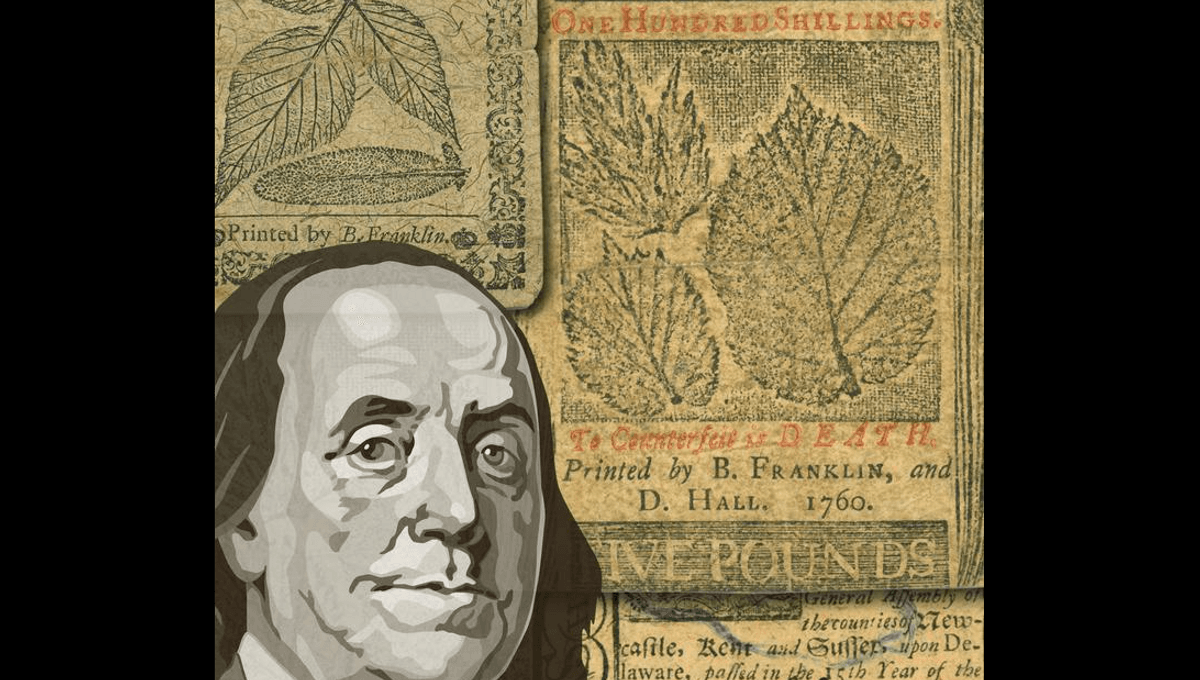
Benjamin Franklin helped America break free of the British currency system by designing paper money that was hard to fake. Some of his techniques have been lost in time, and only now been reconstructed using 21st-century analytic technologies.
After the little things like explaining gravity and the rainbow, Isaac Newton spent the second half of his career sorting out problems with the British Royal Mint. The work helped set the country up for global domination. A century later, Franklin realized that fighting a war while dependent on your enemy’s financial system was unlikely to work, so the revolutionaries needed their own currency.
With the colonies lacking sources of precious metals, Franklin argued the solution was paper money, but needed it to be almost impossible to counterfeit if it was to hold its value. Some of the techniques he used have been incorporated ever since, including the $100 bills that bear Franklin’s likeness, but others were lost in time, until rediscovered in a newly published paper.
“Franklin used natural graphite pigments to print money and developed durable ‘money paper’ with colored fibers and translucent muscovite fillers, along with his own unique designs of ‘nature-printed’ patterns and paper watermarks,” the authors write.
Many of Franklin’s techniques are well known, but Dr Khachatur Manukyan of the University of Notre Dame and co-authors studied over 600 bills, some printed on Franklin’s presses, others on those of his contemporaries or counterfeiters. They used X-ray diffraction and fluorescence, electron energy loss spectroscopy, Raman spectroscopy, and Infrared spectroscopy to reveal the secrets of both the paper and ink, as well as crystal fillers Franklin added to his notes that gave them a specific feel and improved their durability.
Filler flakes that attached to the surface of Franklin’s notes also reflected light when tilted at the right angle. These are absent from the fakes tested, and may have been a good way to tell the difference.
The study reveals the presence of mercury and sulfur in Franklin’s red colorant, and that the blue ink used Prussian blue (Fe4[Fe(CN)6]3). However, he used black the most, and the spectroscopy reveals there was a good reason for this. Although Franklin is known to have purchased a workshop specifically to produce black coloring by burning vegetable oils, he also used natural graphite from metamorphic rocks, which probably didn’t occur to his enemies. The counterfeit notes mostly use “bone black” from the pyrolysis of bones. Those checking the notes would not have known why the inks looked different, it is possible they could spot it.
Franklin also worked blue fibers, colored with indigo, as threads into the paper, creating a difference from printing with blue ink. This approach has been attributed to Zenas Marshall Crane, but thepaper found the thread in Franklin’s paper from 1739, more than a century before Crane..
Franklin’s printing efforts began long before the American Revolution. He established his first printing house in 1728, aged just 22, to address the lack of gold and silver coins. Franklin printed almost 2.5 million notes for the colonies of Pennsylvania’s neighboring colonies, as well as supplying equipment and techniques to printers further afield. Throughout this time, he played a cat-and-mouse game with counterfeiters.
One of Franklin’s first techniques was not original – he borrowed the idea of using the impression of a leaf’s intricate vein structure from Leonardo da Vinci. However, Franklin succeeded in transferring the structure into the printing process in a way his predecessors had not.
Counterfeiters were smart and motivated, however, and no one technique was likely to foil them. Franklin adopted a defense-in-depth approach, using so many features that his notes were almost impossible to copy. Some of these, such as deliberate misspellings that varied with the denominations, have been known to historians since his time, but others remained secrets.
When the revolution came, Franklin was ready, and together with John Adams, organized the printing of money tied to the value of the Spanish American dollar to finance the Continental Army.
Now they were facing not merely ordinary criminals trying to replicate their money, but the entire weight of the most powerful government in the world, which flooded the colonies with bills that resembled Franklin’s. The success of the revolution depended in great part on the British failure to forge copies indistinguishable from the originals.
Although the British failed, the idea of undermining an economy by counterfeiting its money was used in numerous subsequent wars – sometimes with greater success since the printers of those currencies lacked Franklin’s ingenuity.
The study is published in the Proceedings of the National Academy of Sciences
Source Link: Secrets Of Benjamin Franklin’s Anti-Counterfeiting Techniques Have Finally Been Revealed